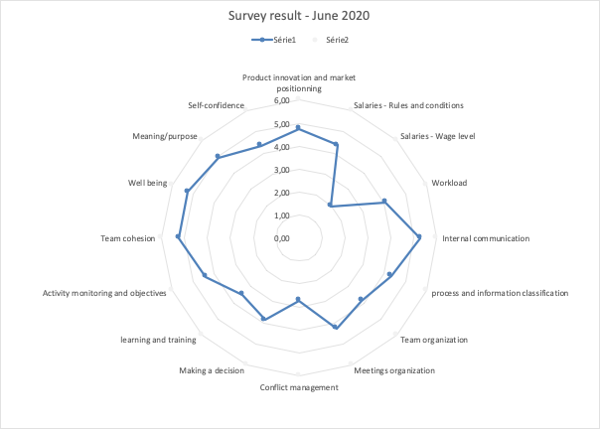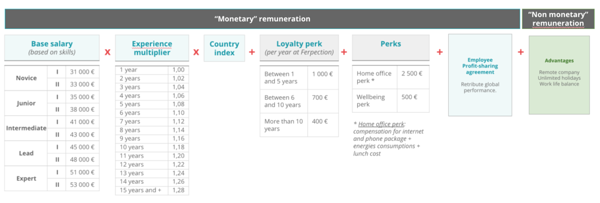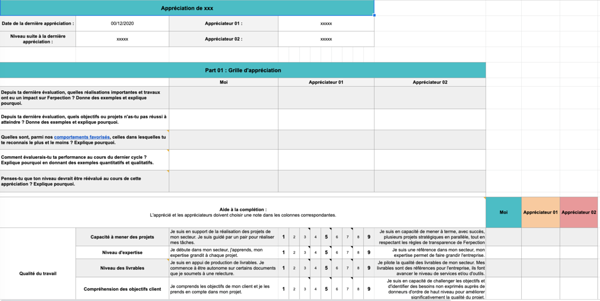February 10, 2021
Choosing Your Salary: New Salary Policy at Ferpection
In 2021, I chose my own salary! I didn't change companies to go to the highest bidder. No, I just pointed out the new amount to be included on my employment contract.
So, after this rather rambling introduction, let's examine how we went about revising our salary policy at Ferpection, and how we allowed everyone to calmly determine their own salary level.
Frustrations - but not departures, yet - lay at the root of this new salary policy
It had to be recognized that compensation had been a source of tension at Ferpection for some time. Perhaps we were hiding behind a sense of, "yes, of course, but just like everywhere else". Things accelerated in June 2020, when we carried out an audit of our organizational maturity which revealed strengths but also two priority areas for improvement:
- Serious frustrations confirmed regarding the level of remuneration, in particular for the profiles with the highest level of experience.
- Misunderstandings and uncertainties about individual progress.
Employees took the matter in hand
A working group was created to address the two frustrations identified. It was made up of one representative from each team and one person with a financial visibility role. The founders were not part of it! However, they would be consulted throughout the process.
The beginning
So, where to begin? To be honest, every lead we started to follow felt like we were pulling a strand out of an endless ball of yarn. So as not to get lost along the way, we laid the foundations, the purpose of our working group:
"We want to define a fair remuneration system and a transparent system of progression by means of which each person can autonomously determine his or her salary and schema for progression."
This is what would then enable us to make decisions throughout the project: "Does this proposal meet our purpose? Yes, No ? → Go / No Go"
Phase 1: Budget and payroll, the lifeblood of the war
What payroll is fair?
The first part of our work, and by no means the easiest, consisted of defining the budget we wanted to allocate to the payroll. For peace of mind about the budget allocated we :
- Worked on a projection of turnover for N+1 and N+2
- benchmarked against similar sectors of activity to ours
- added a 10% safety margin
- sought external help: lawyer, accountant and executive coach. We also had to recognize our limits!
How do you allocate salaries individually?
Once the budget to be allocated was defined, the question was how to distribute it. After external comparisons and internal consultations, we chose to include :
- The level of individual skills.
- The number of years of relevant experience.
- A country index related to differences in the cost of living.
- Loyalty to the company.
- Monetary benefits to compensate for the absence of a work center and the costs associated with telecommuting, because yes, good working conditions from home is a cost!
- Non-monetary benefits specific to our organization as a liberated company: no-questions-asked access to telecommuting, unlimited vacation time, flexibility in schedules.
At that point we already had the impression that we'd made some serious progress up the mountain. "Spoiler alert", we were still far from the top!
Phase 2: how to allow each person to determine their own salary calmly and identify their areas for improvement? 🤯
Feedback culture to the rescue
In retrospect, this was undoubtedly the phase that required the most energy. Consultations, brainstorms, and benchmarking yet again! But, against all expectations, we could not find a system anywhere else that would allow us to meet our need. And, as a reminder, all without management hierarchy. So we compiled our own based on one of the key behaviors at Ferpection: feedback.
We created a grid which enabled each person to self-assess their successes and accomplishments as well as their areas for progress. At the same time, two peers chosen by the person would also conduct the same assessment. That meant they could bring their external viewpoint to the discussion. We even wanted to integrate customer feedback but so far we haven't found the right way to do so!
The self-assessment grid is summarized in three key points
- Open-ended questions allowing a retrospective of the previous business cycle
- Grading based on 4 main areas of competence: quality of work, attitude towards the work, sense of teamwork and shared values.
- Opening and clarification of the next areas for progress.
If you want to go through this grid in detail, ask us, we will send it to you! And please do share your feedback with us, you'll have understood how much we love it ☺️
All feedback is shared and discussed during annual reviews. The average score refers to a skill level on the salary grid. At the end of the review, each person is faced with a choice: if I value myself higher than my peers do, I can always keep a higher level and therefore a higher salary. Now it's up to me to show them that I'm up to the task and take responsibility for this decision!
How will this salary policy develop?
What is the outcome today? First, we're extremely proud to have succeeded in creating and deploying our new salary policy in less than 6 months and in the midst of a pandemic. The first reviews took place between December and January and the increases were distributed right away!
But much remains to be done! The priority is to collect feedback on this first iteration, with some hindsight, from all the people who participated in this new process. We are aware that, although satisfaction is real and has been expressed, new frustrations will undoubtedly arise. We all have a different relationship with money and no one solution can meet all expectations.
Avenues for improvement are already being explored: adding mid-year reviews to ensure continuity of progress, facilitating the choice of assessors, ensuring fairness in assessment, managing disagreements, etc.
The next projects will be identified and prioritized after the feedback is collected, and perhaps they will lead to us writing a new article!
In the meantime, please do share with us how these topics are addressed in your organization, we would love to discuss it!
Ferpection helps companies understand their users' behavior in order to leverage it for their business. Our organization as a liberated company gives us the energy and agility to satisfy our customers every day.
All articles from the category: Culture | RSS





